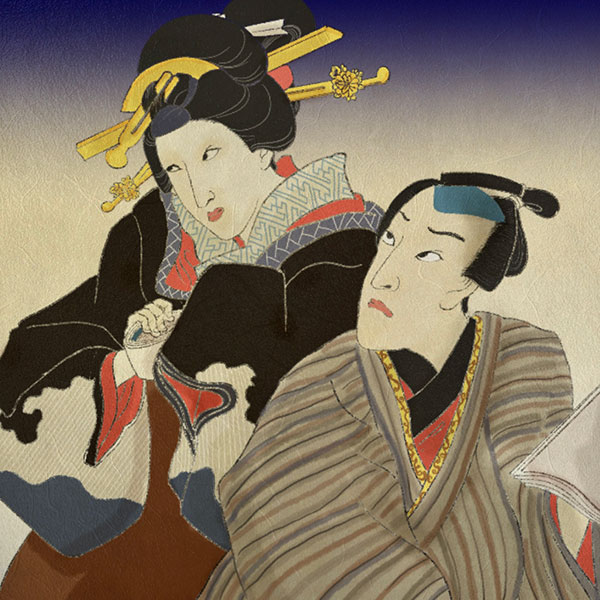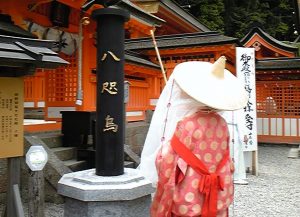The Love Suicides at Sonezaki (1/2)Chikamatsu Monzaemon's representative "tragedy"

The Love Suicides at Sonezaki
- Article category
- case file
- Incident name
- The Love Suicides at Sonezaki (1703)
- place
- Osaka Prefecture
- Related castles, temples and shrines

Osaka Castle
During the Genroku period (1688-1703), under the rule of the fifth shogun, Tokugawa Tsunayoshi, various cultures developed, including theater, literature, art, crafts, and scholarship. One of the masterpieces by Chikamatsu Monzaemon that represents the Genroku period is "The Love Suicides at Sonezaki." This puppet theater, based on a real case of double suicide, captivated people in the Edo period and had a social impact, such as an increase in the number of double suicides. In this article, we will explain "The Love Suicides at Sonezaki" in an easy-to-understand way.
Chikamatsu Monzaemon, author of The Love Suicides at Sonezaki, and Joruri
"The Love Suicides at Sonezaki" is a masterpiece by Chikamatsu Monzaemon, who is known as a writer of joruri and kabuki. Chikamatsu Monzaemon was born in 1653 as the son of a samurai in Echizen Province (present-day Fukui Prefecture). His real name was Sugimori Nobumori, and he served nobles and other nobles, but he eventually became obsessed with puppet theater and began working as a writer as a townsman.
By the way, Joruri is a musical piece that tells a story with a melody to the accompaniment of a shamisen. Originally, it was a "narration" of stories such as the Tale of the Heike to the accompaniment of a biwa, but it was established as a kind of storytelling after the "Joruri Gozen Monogatari" that was popular in the middle of the Muromachi period. The narrator of a Joruri story is called "Tayu".
When this Joruri was combined with puppets operated by puppeteers, "Ningyo Joruri" was formed around the end of the 16th century to the beginning of the 17th century. It developed as a traditional performing art in Osaka and came to be called "Bunraku", and as "Ningyo Joruri Bunraku", it is registered as an intangible cultural heritage of UNESCO.
During the time of Chikamatsu Monzaemon, Kyoto and Osaka were known as the centers of puppet theater. After training under the joruri tayu Uji Kagajo, Chikamatsu went independent and teamed up with the up-and-coming tayu Takemoto Gidayu to perform puppet theater at the Takemotoza Theatre. Today's Bunraku is told in the "gidayubushi" style, and the founder of this style is Takemoto Gidayu. Joruri before Gidayu's appearance is known as "kojoruri." In other words, Chikamatsu was at the forefront of the culture of his time.
After that, Chikamatsu wrote about 30 Kabuki plays for the popular Kyoto actor Sakata Tojuro, and took a break from the world of Bunraku puppet theater, but he returned to it at the request of Takemoto Gidayu, who was struggling with debts. On May 7, 1703 (16th year of Genroku), he performed "The Love Suicides at Sonezaki" at the Takemotoza Theater, and it became a huge hit.
Chikamatsu, who became an exclusive resident playwright at the Takemotoza, moved from Kyoto to Osaka and produced a succession of hit plays, including "The Battle of Kokusenya" and "Shinjuten no Amijima." In his later years, he worked to train his successors, and in January 1724 (the 9th year of the Kyoho era), he released his final work, "Kanhasshu Tsunagiuma." He passed away on November 22nd of the same year, at the age of 72.
Summary of Sonezaki Shinju: Tokubei is deceived
Now, let's take a look at the plot of "The Love Suicides at Sonezaki." Although various adaptations have been made to "The Love Suicides at Sonezaki" since its inception, this time we will introduce a modern translation of the text written by Monzaemon Chikamatsu.
The main characters are Ohatsu, a prostitute at Tenmaya, and Tokubei, a clerk at Hiranoya, a soy sauce maker. This is a story about how these two people commit suicide together, desperate for the world. The story is set in Osaka. On April 6th, Ohatsu, who has just completed her pilgrimage to the Thirty-Three Kannon Temples of Osaka, reunites with Tokubei in Ikudama (Tennoji Ward, Osaka City, Osaka Prefecture). Although the two were in love, Ohatsu criticizes Tokubei for not coming to see her much recently.
In response, Tokubei begins to talk about his own experiences. In fact, Tokubei's work as a servant at his uncle's house was recognized, and there was talk of marriage to the daughter of his relative. Tokubei refused, but his uncle went ahead with the plan and ended up paying a dowry to Tokubei's stepmother.
However, Tokubei was adamantly refusing to marry. His uncle was furious at Tokubei for insisting that he would not marry in favor of a prostitute. He then kicked Tokubei out of the shop and demanded that he return the betrothal money by April 7th. Tokubei got the money back, but on his way to return it to the shop he met his friend Kuhei-ji. Kuhei-ji was a good friend and begged Tokubei to lend him the money, saying he would pay it back by the morning of the 3rd. Tokubei was a kind person and lent him the money, but three days had passed and he still hadn't returned it.
While Tokubei is explaining his situation to Ohatsu, Kuheiji happens to pass by. Tokubei asks Kuheiji for repayment of his debt, but despite even having the document, Kuheiji denies it, saying, "I don't owe you a single penny." Even after he shows him the document, he calls Tokubei a conman, saying, "I lost the seal on the document," and, "You picked up my seal and forged the document!" Feeling betrayed, Tokubei attacks Kuheiji, but is beaten up by Kuheiji's comrades. Ohatsu tries to help, but a customer who was worried about her safety sends him away first.
Summary of Sonezaki Shinju: 2. Two people decide to die
Hurt and in the depths of despair, Tokubei prepares himself for death and heads to Tenmaya where Ohatsu is, knowing that the only way to prove his worth is to die. Ohatsu secretly hides Tokubei under the eaves of the shop. Then a drunk Kuheiji comes in and starts badmouthing Tokubei, lying to him and saying that he is a con man and that he is destined to be beheaded at the execution ground. Tokubei is furious, but Ohatsu does her best to stop him.
Then, in front of Kuheiji, she says to herself, "If things have come to this, Toku-sama must die, but I want to hear his resolve to die," and uses her foot to ask Tokubei, who is standing under the eaves, if he is ready to commit suicide. Tokubei, upon hearing this, takes Ohatsu's foot and places it against her throat like a blade, signaling that he will commit suicide.
Ohatsu responded, "Toku-sama must die to regain his honor." Kuheiji was shocked and said, "What are you saying? Tokubei can't die. If he does die, I'll make you my friend. You seem to be in love with me." But Ohatsu said, "Thank you. If you make me your friend, I'll kill you. Are you aware of that? I can't live even for a moment if I'm separated from Toku-sama. You thief, Kuheiji, who would believe you when you say such nonsense? Whatever happens, I'll die with Toku-sama." She began to cry.
Kuheiji, who is disgusted by Ohatsu, leaves with a parting shot, and in the middle of the night, when the owners of Tenmaya are fast asleep, Ohatsu changes into her funeral attire, a pure white wedding kimono with a black kosode kimono, and sneaks out, hand in hand with Tokubei. They then head to Tenjin Forest in Sonezaki.
Summary of Sonezaki Shinju ③ A masterpiece of travel and a double suicide
There are many masterpieces in Joruri, one of which is the "Michiyuki" from "The Love Suicides at Sonezaki." It is a literary account of the journey from the starting point to the destination, but the journey from Tenmaya to Tenjin no Mori is so beautiful that it cannot be put into words, and was highly praised by a famous Confucian scholar of the time. The opening sentence is particularly famous, and I will quote a few paragraphs here.
"The lingering nights of this world compare to my own demise. The frost on the road in Adashigahara fades with each step. A dream within a dream is truly pitiful. Counting them, I see six of the seven dawn hours, and the one remaining is the sound of the bell of this life. I wake up, and nirvana is bliss."
The song uses an overall 7-5 rhythm, rhymes with words such as "this world" and "night," and makes full use of related techniques such as using related words such as "frost" and "disappearing," to convey the sadness of those who are dying and a heartbreakingly beautiful scene.
A literal translation would be "The end of this world, the end of the night. If we were to compare the bodies of the two dying people, it would be like the frost that falls on the road in Adashigahara (= the cemetery) disappearing one by one. It is pitiful, like a dream within a dream. Counting, six of the bells have rung at the seventh hour of dawn, and the last one remaining is the last bell to be heard in this life. It is ringing out that if you enter the state of nirvana, you will be able to find true peace..." In this case, nirvana, or nirvana, is a metaphor that means death.
Afterwards, the two of them vow to be together in the next life, swearing eternal love to the Fortune Tree (a symbol of marriage and marital harmony) in Tenjin Forest, which is close to the gods, and tie themselves to the tree with their sashes. Tokubei then tries to take the life of his beloved Ohatsu with his wakizashi, but hesitates. However, in the end, the wakizashi cuts Ohatsu's throat. Tokubei then stabs himself into the throat, saying, "I will not be late. Let us take our last breath together," and commits suicide.
At the end of the Joruri, it is stated that the story of the two lovers spread throughout the world, spread among many people regardless of their social status, and they were memorialized, so there is no doubt that they both attained nirvana in the afterlife, and it concludes with the words, "They have become an example of love."
Is the domestic drama Sonezaki Shinju a true story?
With "The Love Suicides at Sonezaki," Chikamatsu Monzaemon established the genre known as "sewamono." Sewamono are plays that are set against the backdrop of the lives and customs of townspeople in the Edo period and feature love affairs and everyday incidents. In fact, when Chikamatsu was a Kabuki writer, he wrote plays called "sewa kyogen," which feature everyday incidents that affect the common people, and he used that technique to write his sewamono plays.

- WriterNaoko Kurimoto(Writer)I am a former travel industry magazine reporter. I have loved history, both Japanese and world history, since I was a child. I usually enjoy visiting temples and shrines, especially shrines, and often do ``pilgrimages to sacred places'' themed around historical figures. My favorite military commander is Ishida Mitsunari, my favorite castle is Kumamoto Castle, and my favorite castle ruins is Hagi Castle. My heart flutters when I see the ruins of battle castles and the stone walls of castle ruins.



